Tongue mapping research: CSU device lets you hear with your tongue
by Kortny Rolston | January 12, 2015 10:23 AM
Endnotes:
- Department of Mechanical Engineering: http://www.engr.colostate.edu/me/
- [Image]: http://source.colostate.edu/wp-content/uploads/2015/01/Hearing-w-tongue-how-it-works.jpg
- College of Veterinary Medicine and Biomedical Sciences: http://csu-cvmbs.colostate.edu/Pages/default.aspx
- research at CSU: https://source.colostate.edu/tag/research/
- Leslie Stone-Roy: http://csu-cvmbs.colostate.edu/academics/bms/Pages/leslie-stone-roy.aspx
- Pkg with graphics: http://vimeo.com/116478817?email_id=Y2xpcF90cmFuc2NvZGVkfGIzM2Q5NmQxMjFmZjAxN2M0MjJhZjAzMjYzMzQxM2NkNTYzfDEzMzYzMDkwfDE0MjEwNzk2ODF8NzcwMQ%3D%3D&utm_campaign=7701&utm_medium=clip-transcode_complete-finished-20120100&utm_source=email
- Pkg, no graphics: http://vimeo.com/116380986?email_id=Y2xpcF90cmFuc2NvZGVkfDdjOWE4ZTk0OGZmM2MzNDA4MmE3OGVjZjMyMmIyNTMzNTI4fDEzMzYzMDkwfDE0MjA4Mzk4NzF8NzcwMQ%3D%3D&utm_campaign=7701&utm_medium=clip-transcode_complete-finished-20120100&utm_source=email
- Pkg script: http://source.colostate.edu/wp-content/uploads/2015/01/Tongue-Mapping-pkg-script.docx
- SOT – Leslie Stone-Ray: http://vimeo.com/116481029?email_id=Y2xpcF90cmFuc2NvZGVkfGUwYTFkZGNmZmY2Yjk5MGIxY2MxZmExMjdjNjVhNWM3MTU1fDEzMzYzMDkwfDE0MjA5OTk3NTh8NzcwMQ%3D%3D&utm_campaign=7701&utm_medium=clip-transcode_complete-finished-20120100&utm_source=email
- SOT and b roll: http://vimeo.com/116381541?email_id=Y2xpcF90cmFuc2NvZGVkfDMzNGRkODQ3MjA3N2QxMzllOTY4ZmQzODc4YjA3OTRkMTA4fDEzMzYzMDkwfDE0MjA4NDAyNjB8NzcwMQ%3D%3D&utm_campaign=7701&utm_medium=clip-transcode_complete-finished-20120100&utm_source=email
- [Image]: http://source.colostate.edu/wp-content/uploads/2015/01/group-tongue-photos.jpg
- [Image]: http://source.colostate.edu/wp-content/uploads/2015/01/john-tongue-device.jpg
- [Image]: http://source.colostate.edu/wp-content/uploads/2015/01/student-tongue-mapping.jpg
Source URL: https://source.colostate.edu/words-mouth-csu-device-lets-hear-tongue/
Copyright ©2024 SOURCE unless otherwise noted.
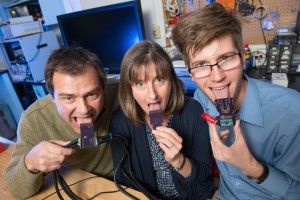
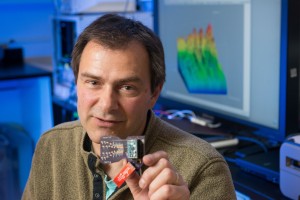 Sign Language and Braille are both examples of sensory substitutes.)
Sign Language and Braille are both examples of sensory substitutes.)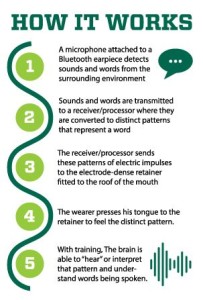 [2]hem to a speech processor, which analyzes the information and transmits it to a receiver where it is converted into electric impulses. The implant sends those impulses directly to the auditory nerve. With training, the brain learns to recognize these impulses as useful sound information.
[2]hem to a speech processor, which analyzes the information and transmits it to a receiver where it is converted into electric impulses. The implant sends those impulses directly to the auditory nerve. With training, the brain learns to recognize these impulses as useful sound information.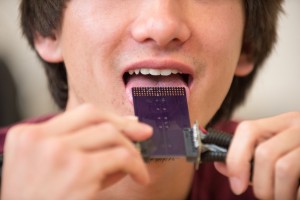
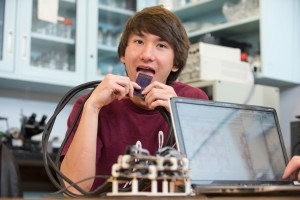 he auditory nerve. The surgical procedure has inherent risks and can cause additional damage to the sensory cells in the inner ear that transmit sound to the auditory nerve.
he auditory nerve. The surgical procedure has inherent risks and can cause additional damage to the sensory cells in the inner ear that transmit sound to the auditory nerve. [11]
[11]
 [12] Dr. John Williams, who is leading the project, envisions the device as being a non-surgical alternative to cochlear implants.
[12] Dr. John Williams, who is leading the project, envisions the device as being a non-surgical alternative to cochlear implants. [13] CSU researchers are testing the nerves on the tongue to see which are best at detecting the electrical impulses necessary for the device to work.
[13] CSU researchers are testing the nerves on the tongue to see which are best at detecting the electrical impulses necessary for the device to work.